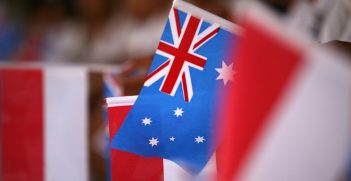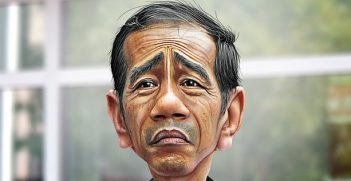Why the US struggles against Japan in TPP negotiations
![TOKYO, Japan (April 24, 2014) U.S. President Barack Obama participates in the welcome ceremony with His Majesty the Emperor of Japan at the Imperial Palace during his state visit to Japan. [State Department photo by William Ng/Public Domain] TOKYO, Japan (April 24, 2014) U.S. President Barack Obama participates in the welcome ceremony with His Majesty the Emperor of Japan at the Imperial Palace during his state visit to Japan. [State Department photo by William Ng/Public Domain]](http://20.185.176.227/wp-content/uploads/2014/08/Barack_Obama_and_Emperor_Akihito_20140424-e1409278407545.jpg)
Professor Aurelia George Mulgan looks into the negotiation dynamics between the United States and Japan during the talks on the Trans-Pacific Partnership Agreement.
Real progress in Trans-Pacific Partnership (TPP) negotiations has stalled until Japan and the United States reach some kind of basic trade agreement — which is still elusive even after numerous rounds of talks. The United States has been pressuring Japan to make concessions in key areas such as agriculture.
It is well known that current TPP negotiations are running on two separate tracks: the plurilateral track in which all 12 countries are participating and the bilateral track which amounts to a series of bilateral deals being negotiated on the side.
Certainly the second track has been more important for the United States and Japan, making any progress on reaching a TPP agreement hostage to a surrogate US–Japan FTA.
Chairman of the Liberal Democratic Party’s (LDP) TPP Affairs Committee Koya Nishikawa has explained that the government’s strategy is first to secure exceptional measures for rice, wheat and sugar and then to maintain the advantage in the negotiations on beef, pork and dairy products. Nishikawa has asserted that ‘the negotiating team will only accept numbers that will allow us to keep our promises with the people’ (to protect ‘sensitive’ farm products). The current focus of US–Japan negotiations appears to be those numbers.
The Japanese media have attempted to divine what is happening in the negotiations. One report suggested that the Japanese government was considering a special import quota under which American rice would be prioritised over rice from other countries. This would be agreed in order to keep tariffs on rice and other products (such as beef, pork, sugar and wheat) on the ‘sensitive’ list. The report also claimed that the United States was making demands that Japan could not accept, such as ‘effectively excluding’ cars by taking more than 30 years to abolish tariffs on car imports.
These reports prompted one LDP agricultural committee executive to ask, ‘when did the TPP turn into a Japan–US EPA?’
Historically, outside pressure (gaiatsu) from the United States has been effective in prising open Japanese markets in both bilateral and multilateral trade negotiations. During earlier decades of bilateral trade friction, resolving disputes with the United States was the most important driver of Japanese trade policy. Even multilateral negotiations under the GATT were accompanied by bilateral US–Japan discussions on the side. So if gaiatsu has worked so well in the past, why is it not working now?
First, ever since the establishment of the WTO, Japan has handled trade friction with the United States through the WTO’s ‘enhanced dispute settlement mechanism’. Using the legalised multilateral framework of the WTO strengthened Japan’s bargaining power over time and weakened US pressure on Japan regarding trade-related issues.
Second, Japan is no longer considered an industrial rival of the United States in the way it was at the height of US–Japan trade friction in the 1980s. The ‘threat’ of Japan Inc. — the idea that ‘government and industries are one’ — no longer exists, if it ever did. Nor does the revisionist view of Japan (ishitsuron) as ‘different to us’ continue to influence American negotiators.
Third, gaiatsu is not viewed in the same way by the Japanese as it was in previous decades. Previously, pro-reform elements in the Japanese government harnessed gaiatsu in order to strengthen their cause against anti-reform elements. But this is now viewed as weak because, as the Nikkei said more than 10 years ago, it looks as if ‘the government lacks both the will and the means to reform itself on its own’.
Fourth, experience has already shown that a tough negotiating stance from the US in the TPP talks need not be taken too seriously. During preliminary consultations about Japan possibly joining the TPP negotiations in early 2012, the United States announced a policy of ‘not approving Japan’s participation in TPP talks’ unless all items, including rice, were put on the negotiating table for tariff elimination. But it later backed off.
The most important reason, however, is that Japan places a very high premium — in both trade and strategic terms — on its participation in the TPP. As LDP Secretary-General Ishiba told TPP Minister Akira Amari, ‘the TPP without Japan is pointless’.
Without Japan the TPP would be much less significant. Japan’s participation amplifies both the economic and strategic importance of the TPP for the US. Japan’s involvement enables the TPP to effectively compete with the China-led Regional Comprehensive Economic Partnership (RCEP), which involves Japan but not the US. Absent Japan, the TPP becomes a bit of a sideshow in the US strategic game against China and hardly the vehicle to facilitate the US rebalancing to Asia that America would like it to be. Hence threats to expel Japan from the TPP negotiations carry little weight.
Japan is also well aware that the TPP is hostage to political discord in Washington. Unless the Obama administration has fast-track authority from Congress, which is by no means assured, the US cannot exercise full bargaining power in negotiations. In the meantime, there is no incentive for Japan to engage in the final stages of the negotiations.
Finally, Japan’s fate is now tied more to Asia in economic terms than to the United States. Although America was restored to its long-held position of Japan’s number one export market in 2013 (just ahead of China) most of Japan’s main export partners are Asian but non-TPP countries: China (18 per cent); South Korea (8 per cent), Taiwan (6 per cent), Thailand (5 per cent) and Hong Kong (5 per cent). In strictly trade terms, these figures tend to diminish America’s relative economic importance to Japan. While Japan still relies on the United States for regional security, it does so much less as an export market than it has in the past.
Aurelia George Mulgan is Professor at the University of New South Wales, Canberra.
This article was originally published by the East Asia Forum. It is republished with permission.





